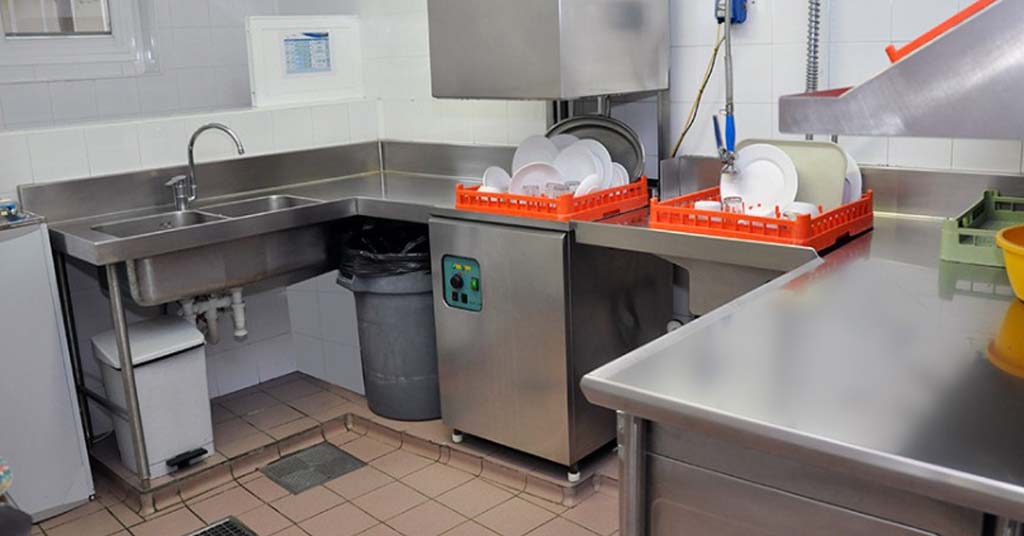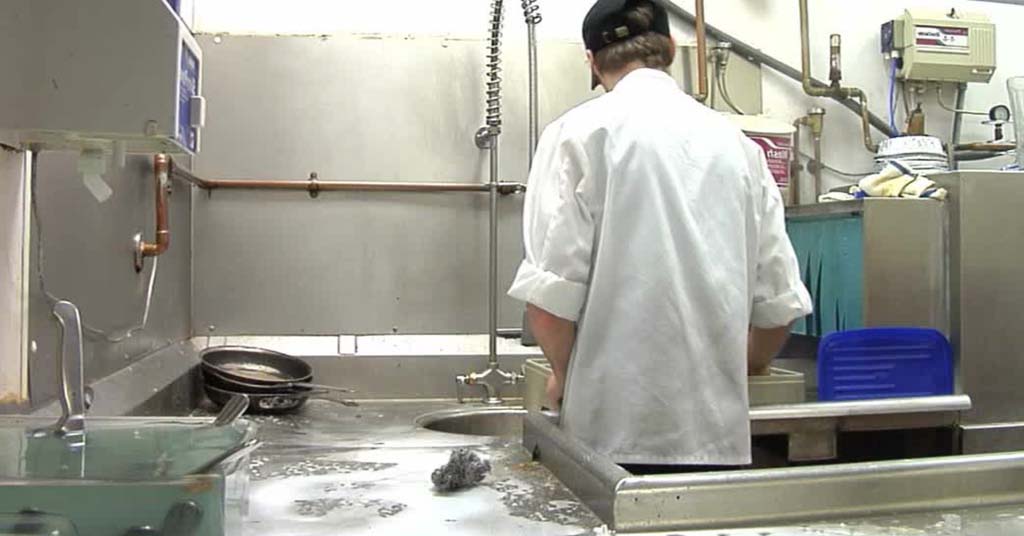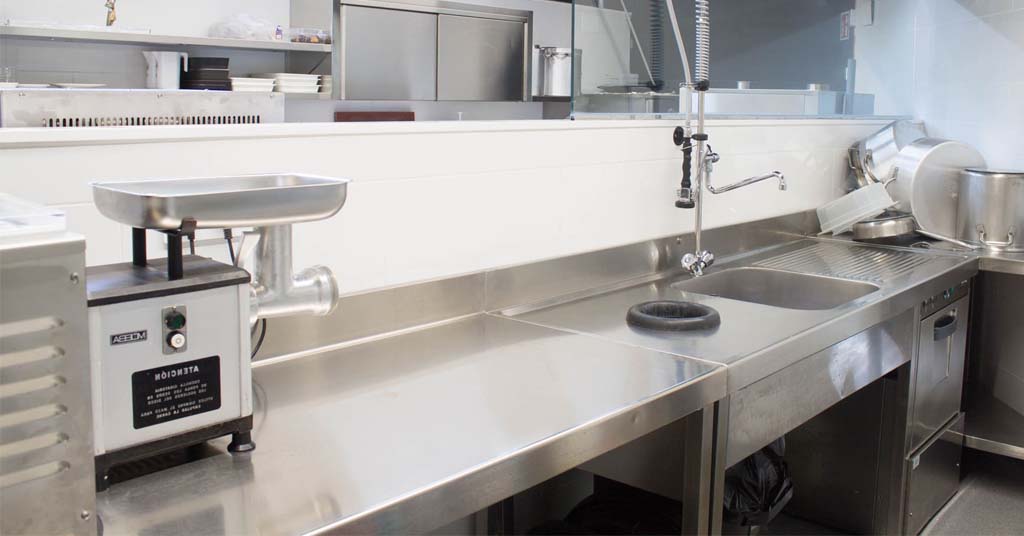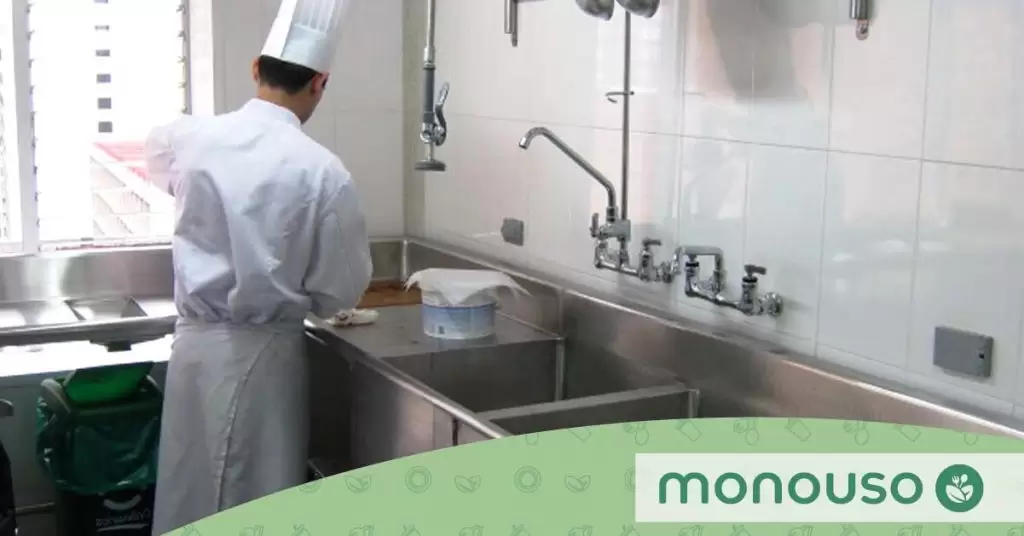The kitchen laundry area is an essential is an essential space to function optimally in your restaurant.
This area is where all the utensils that were used during the preparation of the dishes are cleaned, including the cutlery and crockery used by the diners during their stay.
5 areas of an industrial kitchen and their functions
The industrial kitchen is the most important space in a food business. It is essential and mandatory that it has order and excellent hygiene. It can be divided into five basic areas:
- Storage area. This is the area where all the food is kept. If some of them need to be kept cold, they should be placed in cold rooms or refrigerators.
- Pre-preparation areas. This is where the dishes to be served to customers are prepared, such as main courses or salads, among others. It is important that this area be equipped with specific machinery such as grinders, graters, etc.
- Cooking area. This area is where the dishes to be offered on the menu are prepared. As a general rule, this is where various preparation equipment is located, such as fryers, pasta cookers, etc.
- Plating and collection area. This area is where the dishes are served and where they rest until the waiters come to pick them up. The use of the salamander or hot tables to keep the food warm is recommended for this area.
- Washing area. This is the area where all the kitchen equipment and utensils that have been used during food preparation and service are cleaned.
Zones of a washing area in an industrial kitchen
For the industrial kitchen of a restaurant to function optimally, it is important that the washing area is divided, in turn, into several areas, which we can distinguish as an exterior washing area and an interior washing area.

- Reception area: This area is close to the area where the services are dispatched. Its function is to receive the dirty dishes and utensils to be washed.
- Decomide area: This is the area where the decomide process takes place, i.e., where the leftovers are removed.
- Pre-washing area: In this area the material to be washed is prepared and left ready to be placed in the dishwasher.
- Dishwashing area: There are several types of dishwashers, which vary according to their size and capacity. In this area the utensils to be washed in this type of appliance are incorporated, in order to make the work flow in this area more efficient.
- Cleaning area: Once the dishwasher washing cycle is finished, the clean dishes are placed on a table, then sorted and taken to the shelves where they are stored until the next service.
How to equip an industrial kitchen with a warewashing area: 3 key steps
Every industrial kitchen should be equipped with a warewashing area. Below, we will review 3 key steps that must be fulfilled to ensure optimal operation of this space in your restaurant:

1. Physical and logistical facilities
This part of the industrial kitchen needs certain conditions to ensure its proper functioning. This is because it is the most humid area of the restaurant, as it generates a lot of steam and noise.
During the installation and logistics phase, you must make sure that your laundry area has:
- Adequate flooring and an optimal drainage system.
- Countertops made of marble, granite or stainless steel, preferably.
- Power and gas connections.
- Availability of hot and cold water.
- Lighting, since quality control of the cleaning and condition of the dishes will require good visibility.
- A good system to prevent drainage from clogging.
2. Division of crockery and kitchen utensils
The most advisable is to divide the washing area into two parts:
- The first, will serve to wash the dishes where food and beverages are served to the diners.
- The second will be for cleaning the utensils used to prepare the dishes. This is because the level of soiling and cleaning requirements are very different.
In addition, the washing of crockery, cutlery and glassware needs more care, since in many cases, they are delicate elements that need more attention and time.
On the other hand, pots, pans, trays and kitchen utensils need intense cleaning, as they tend to accumulate grease residues. Therefore, the equipment and chemical products to be used for their cleaning must be stronger.
3. Manual and mechanical washing
In the washing area of an industrial kitchen, dishwashing machines are widely used, since an efficient and fast process is needed given the number of people served.
However, if it is a small business, hand washing is usually used, since it means a lower cost, although in many occasions it implies greater risks.
In many restaurant kitchens a mixed wash is used. This allows a process of mechanical and manual washing, especially for cleaning pots and pans and kitchen utensils.
Kitchen washing area: what to consider before you begin
Catering machinery and other tools that are required in a business should be planned before their purchase. Below, we will tell you which are the aspects you should consider in order to fulfill its ultimate purpose in an optimal and effective way:

Type of business
The first thing to be clear about is the type of business, that is, whether it is a restaurant, a bar, a cafeteria or a dining room, to name a few examples. Each of these places requires different equipment in terms of size and types of machines.
Space
It is also essential to make an assessment of the space available for the industrial kitchen. This in order to establish and determine how the space will be distributed to add the laundry area.
It should be considered that all this space will have kitchen furniture, machinery, utensils and other hygiene elements.
Cleaning materials and utensils
It is quite obvious that a laundry area must have chemical cleaning materials, such as soap, degreaser, hypochlorite, and other products. Consider the types of products you need, and the brand manufacturers to ensure quality. Even more so, when these products will be used in machines such as dishwashers.
Also, you must have different utensils that will facilitate the washing process, especially when it comes to manual washing. Among them are different types of sponges, gloves, brushes, and other tools that will help to wash efficiently.
Machinery
When it comes to an industrial kitchen, washing machinery will be essential to ensure efficiency and effectiveness in this process. Be sure to choose machinery with the right size and capacity to meet the volume your business needs. Also, you should consider the wide range of models and brands that the market offers in dishwashers and the rest of the machinery you will need.
Regarding dishwashers, we can find different options of machines:
- Hood or dome. They occupy a larger space, they are useful for large volumes of washing: long services, large clientele…
- Front-loading. Small and versatile, they have specialized models for fine parts.
- Trailed or conveyor. These are reserved for large-scale projects and are composed of large systems.
Furniture
Although there is furniture made of various materials, the most recommended is furniture made of stainless steel, since it guarantees kitchen hygiene. Work tables are important in the industrial kitchen, as well as shelving, sinks, faucets, service carts, etc.
So far, our post about restaurant washing area. From Monouso we hope it has served you as guidance to fulfill a successful installation of this area in your business.
Learn much more about other related terms in our Hospitality and Catering Dictionary.
Frequently Asked Questions
What is the washing area?
The kitchen washing area is an essential space for the optimal functioning of your restaurant. This area is where all the utensils that were used during the preparation of the dishes are cleaned, including the cutlery and crockery used by the diners during their stay.
What types of laundry area can we find?
Outdoor laundry area and indoor laundry area.
What should a laundry area contain?
Cleaning materials and utensils, furniture and machinery.

